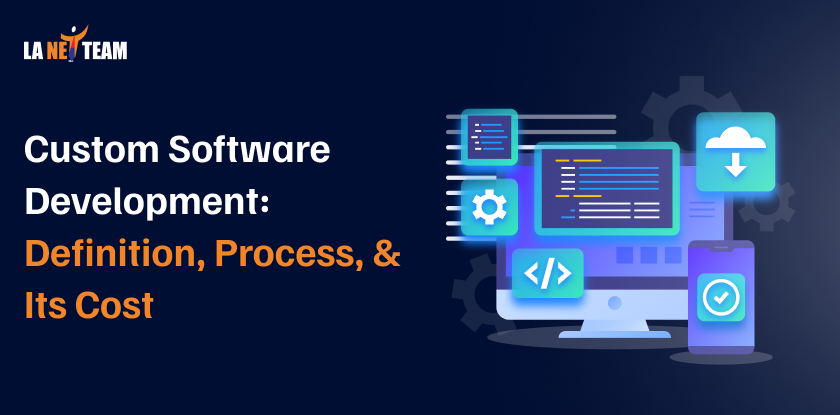Every business works differently, so why should their software be the same?
I once tried using ready-made software, thinking it would make work easier.
But soon realized….. It’s not working well for every work. Some features were missing, and some were just of no use.
That’s when I understood the power of custom software.
Custom software development is a type of software built specially for your business.
In fact, a Statista report shows that over 65% of businesses now prefer a custom-built software solution. Because they improve efficiency, user experience, and long-term ROI.
To know more about it in detail, read more.
What Is Custom Software Development?
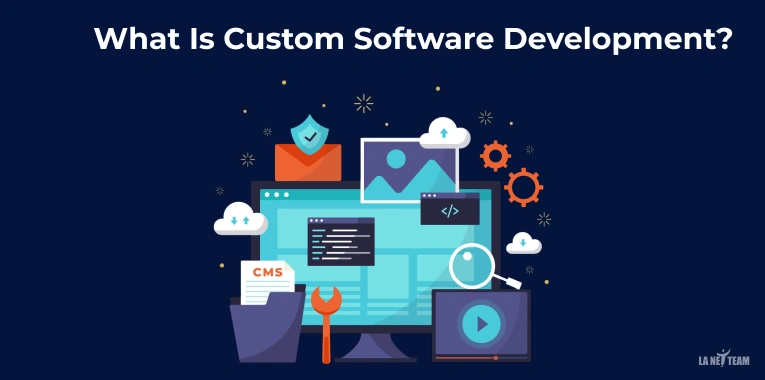
Custom Software Development is the process of creating a computer program or application specifically for a business or an individual.
Unlike ready-made software (such as Microsoft Word or Shopify), which is made for everyone. Custom software is designed to meet your exact needs and requirements.
Reasons to choose:
- Fits your business requirement
- Improve work efficiency
- Scale as your business grows
- Provides better security
Custom Software Vs Off-the-Shelf Software
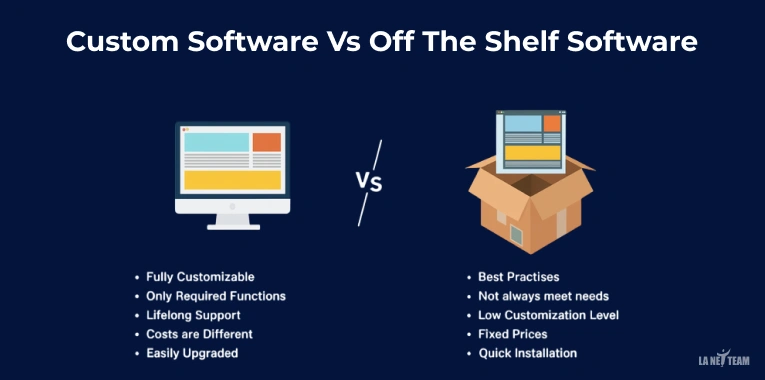
| Aspect | Custom Software | Off-the-shelf software |
|---|---|---|
| What it is | Made just for your business, based on your needs. | It’s a ready-made software made for many users and businesses. |
| Flexibility | Can be changed or expanded as your business grows. | Hard to change, it only works the way it was made for. |
| Cost | More expensive upfront because it’s built for you. | Cheaper at first, but extra features may cost more later. |
| Speed | Takes longer to build and launch. | Can be used immediately. |
| Fit | Perfectly matches your business processes. | It’s generic, may not match all your specific needs. |
| Maintenance & Updates | Updates are done as per your needs and requirements. | Updates are done by the software maker, which may not match your exact needs. |
| Security | Extra security can be added as per your requirement. | There’s only standard security for general use. |
Pros And Cons Of Custom Software
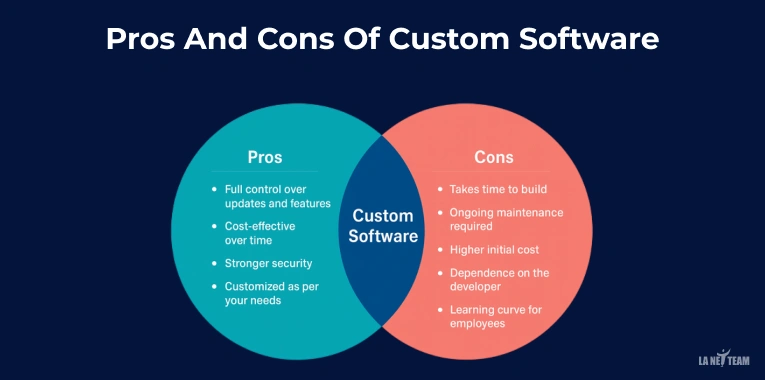
Pros
- Full control over updates and features: You decide what features to add and when. The software grows with your goals and always stays useful.
- Cost-effective over time: It costs more at the start, but over time, it can save you money. You won’t have to keep paying for new versions or features you don’t need.
- Stronger security: You can build in strong security that fits your business needs. This helps protect your data and lowers the risk of hacks.
- Customized as per your needs: Custom software is made to fit your business. It matches how you work and fixes your exact problems, not everyone else’s.
Cons
- Takes time to build: Custom software takes a while to build because it’s made from scratch to match your business perfectly.
- Needs regular care: Just like a car needs servicing, your software also needs updates and small fixes from time to time. You’ll have to keep some time and money aside for that.
- Costs more at the start: Making your own software can be a bit costly in the beginning. But remember, it’s made only for your business, so it’s a one-time smart investment.
- You rely on the developer: If your developer leaves or takes time to respond, fixing or updating your software might get delayed. So, always stay in touch or keep a backup developer ready.
- Learning curve for employees: Your team might need a bit of time to learn how to use the new system, but good training can make that easier.
Step-by-step Custom Software Development Process
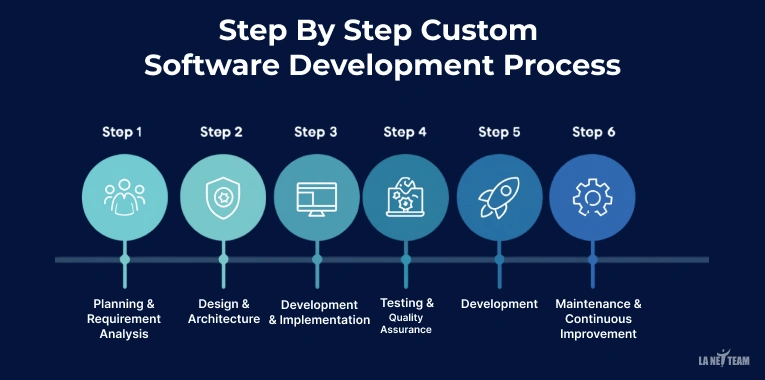
Custom software development follows a step-by-step process, turning a client’s unique idea into a custom software solution. This process is usually called the software development life cycle. Let’s see the breakdown:
Step 1: Planning & requirement analysis
This is where everything begins. It begins with the generation of the idea, in which the team and client brainstorm to clarify the purpose of the software and the business they want to accomplish. Also, collect data to make the final product constructed according to the needs of the users.
Step 2: Design & architecture
During this stage, designers work on the UI/UX design to make the software user-friendly and visually appealing.
At the same time, system architecture involves planning the technical structure of the software. This ensures it’s scalable, secure, and integrates seamlessly with other systems.
Step 3: Development & Implementation
In this stage, the team starts coding to build the software by creating databases and features that bring the software to life.
At the same time, this stage also involves integration. This ensures the software works smoothly with existing systems like CRMs, payment processors, or other tools for perfect overall functionality.
Step 4: Testing & Quality Assurance
This stage is about doing testing to ensure quality. During this phase, the software undergoes rigorous testing to ensure that the quality standards are met.
Step 5: Deployment
As soon as the software is tested completely and has compromised on the problems, it is good to launch it. Deployment refers to the act of transferring the software in a development environment to an actual production environment.
Step 6: Maintenance & Continuous improvement
Once it is deployed, it is time to maintain and do continuous improvement. This includes frequent upgrades, bug fixes and security patches to ensure that it is running well.
How Much Does Custom Software Development Cost In 2026?
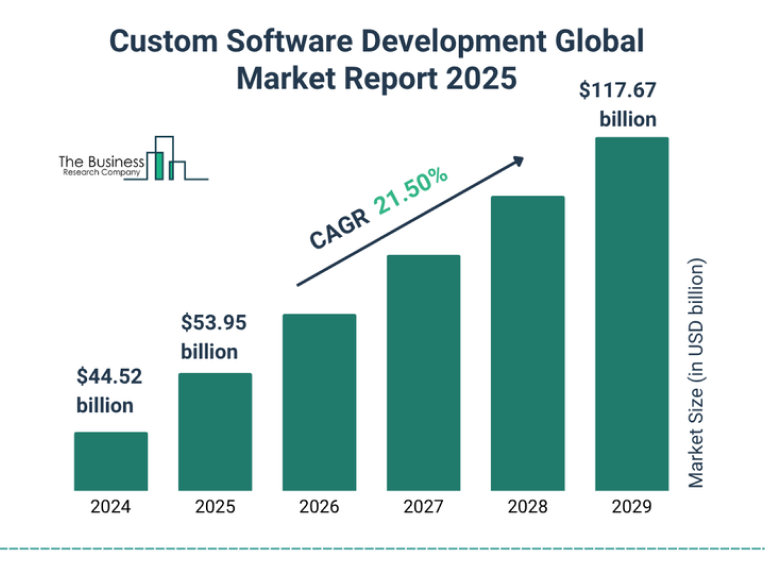
The cost is an element that assists you in gauging the actual investment hence it is crucial to determine the cost of your software.
Custom software may cost between 20,000 and above half a million dollars. However, keep in mind, it is a customized software, thus, the prices differ with the requirements, as the name implies.
Cost breakdown by Project type/size
- Simple/MVP Applications: $20,000 – $50,000
Good when a simple concept should be tested out or a first version is to be created. - Medium-Sized applications: $50,000 – $200,000
Good in the context of a developing business when it has to have sophisticated functions and external connectivity. - Enterprise Solutions: $200,000 – $1,000,000
Good with a big business with tons of features, security, and scalability.
How to estimate your cost?
- Define your project: Start by listing what you actually want your software to do. What’s the main goal? What features do you really need right now?
- Determine scope: Clearly define whether you require a simple MVP or a fully featured, large-scale solution.
- Research development teams: Check out different software companies or freelancers. Make a fair comparison between their experience, prices, and previous work.
- Add phases: Do not forget that there is a cost of planning, designing, development, and testing.
Wrapping Up
Custom software is like a business-specific tool. It does what you want it to do and does it in the manner that you require.
It may be a little more expensive and time-consuming to develop. Yet in the long run, it will help save you money, help in simplifying tasks, and securing your data. Besides, it can expand as your business expands, so you will no longer need to purchase new software.
When done correctly, a good developer, and proper training of your staff, custom software can make your job quicker, more comfortable, and stress-free.
